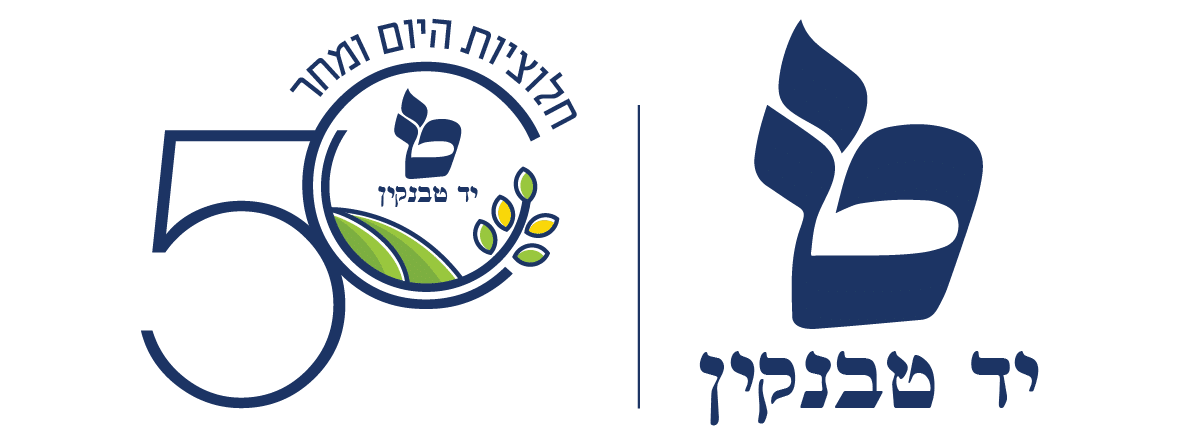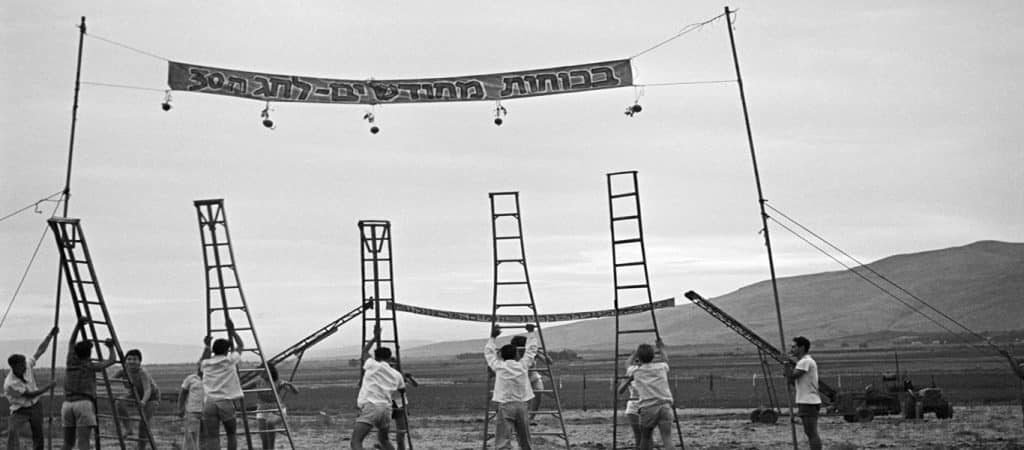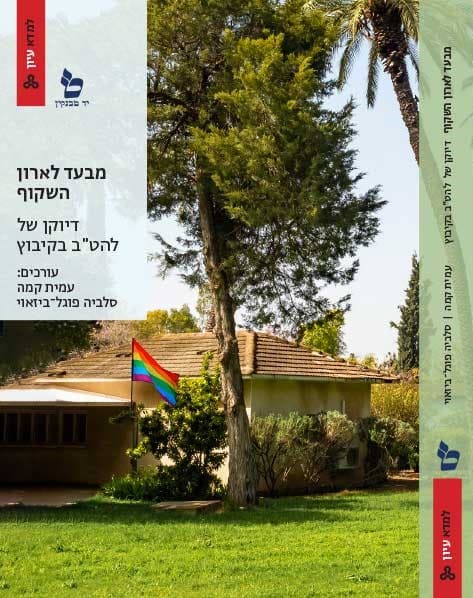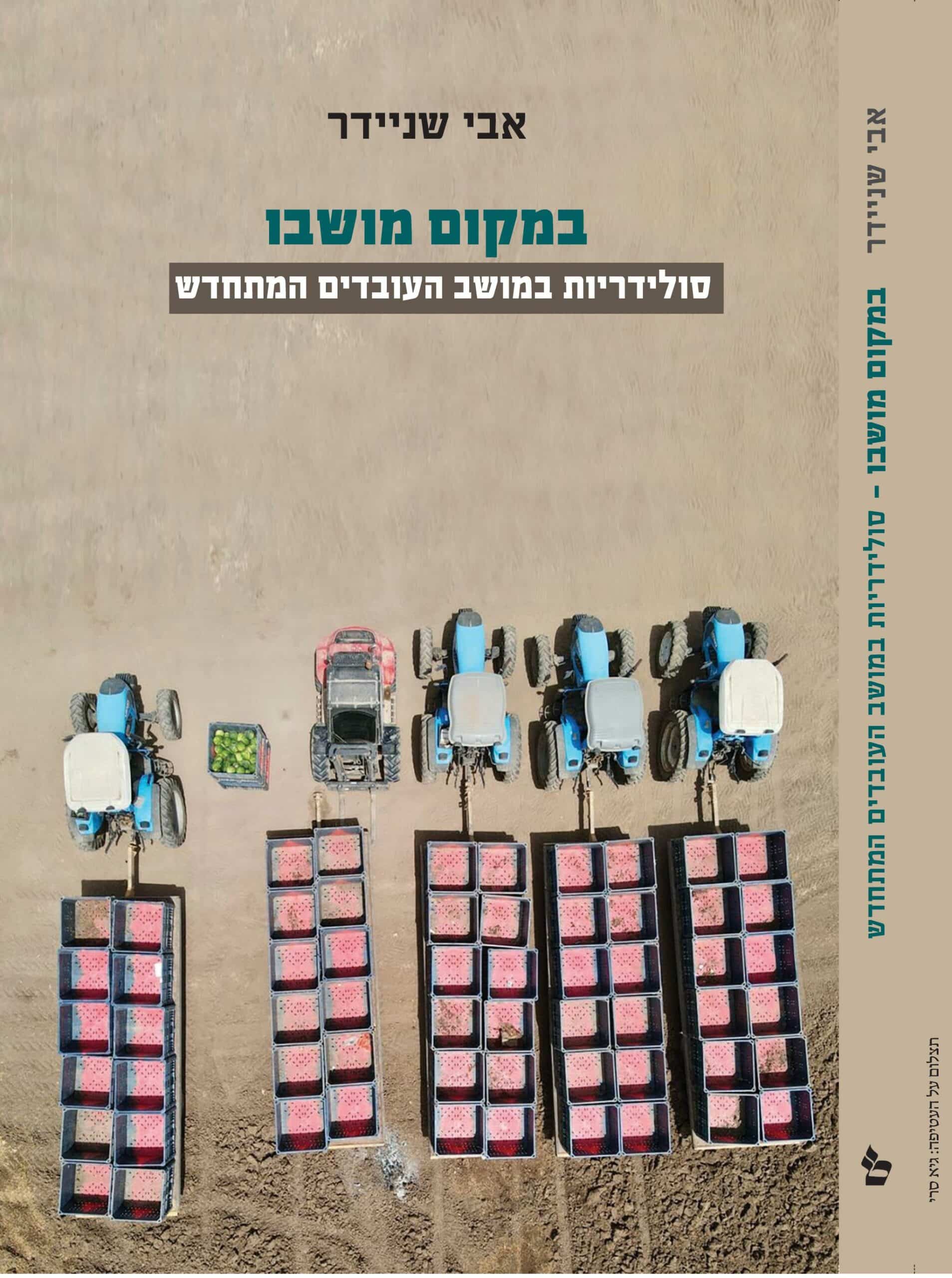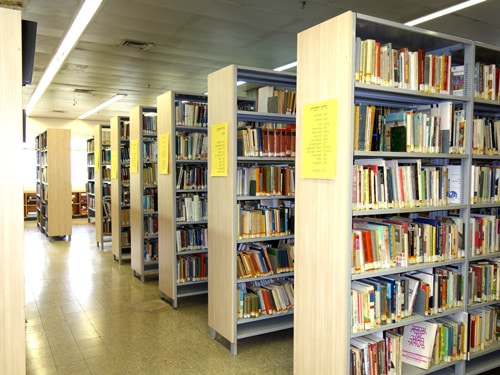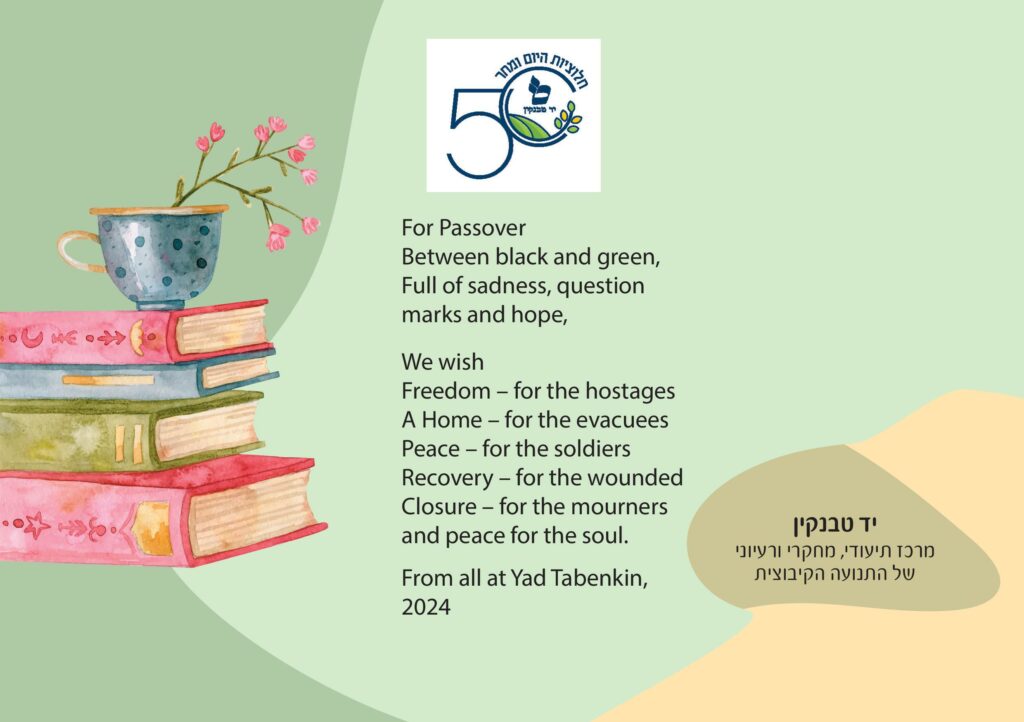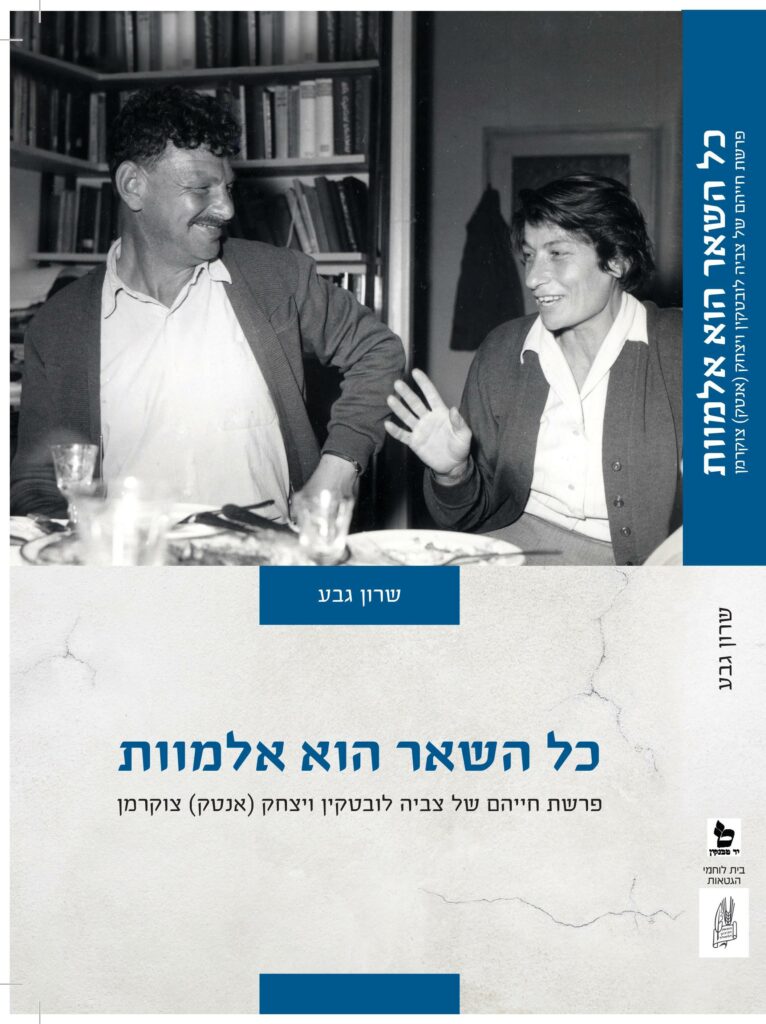Orna Shemer and Menachem Topel

Introduction
This book is the product of a research initiative of the Yad Tabenkin Research Institute, whose studies focus on the world of the kibbutz and collective communities in the past and present. The research initiative presented in this book sought to develop a deeper understanding of the phenomenon of inclusion and diversity in collective communities in Israel. This challenging subject, examining inclusion in communities in which the characteristics of their members were naturally more similar than diverse, was chosen following participation in the ICSA[1] conference of intentional communities addressing this subject. In preparation for the conference, a research group was established in Yad Tabenkin which sought to understand this phenomenon through anchoring and initiating research, and this book is the product of that research group. At the outset of the research process, it became clear that there was no historical research focused on inclusion in the kibbutzim, a fact that raised questions regarding the place of the phenomenon in kibbutz consciousness, and which led from there to deepening research into the concepts of inclusion and exclusion.
The developing discourse on inclusion and exclusion
The concepts of exclusion and inclusion seemingly indicate two poles of a behavioral continuum of individuals or groups, in which the pole of inclusion is characterized by acceptance and integration of the “other,” while the pole of exclusion is characterized by alienation, distancing and oppression. In practice, as the articles in this book demonstrate, the line between the experiences of inclusion and exclusion is often deceptive and thin. Thus, for example, mechanisms of inclusion may simultaneously exclude other groups, or include them only under certain conditions that are revealed over time, while mechanisms of exclusion can derive from the desire to create a separated space that is protected and surrounded. Thus, the processes are not opposites, and they can happen simultaneously in the same space (Silver, 2007).
According to theoreticians such as Jung and Bion, inclusion, in a psychological context, relates to a meaningful process in a person’s emotional development that helps to develop self-acceptance. In a wider context, social inclusion promotes full participation of individuals and groups in situations of risk or inferiority of any kind (Walker, Le Masson & Samuels, 2015). According to this definition, which was adopted by the United Nations, inclusion means equality of rights for people despite the contexts in which they live, so that they can fulfill their full potential in life. Inclusion must therefore be understood in the contexts of politics, power relationships and social participation. Following on this, social exclusion is a process of marginalization of groups in the population on the basis of their social identity, such as people living in poverty or people with disabilities. Exclusion happens through dynamic, multidimensional barriers of organizations, groups and systems that prevent these groups from accessing, integrating, establishing, and exercising rights, expressing cultural identity, and developing, sometimes at the existential level.
According to Doron (2006), the reason for exclusion also reinforces it – that is, what is perceived as lack and weakness creates the experience of exclusion. The lack of access to sources of power turns exclusion into a multi-dimensional experience of inequality in aspects of consumption, political activity, and social integration. Hence in practice many of those who most need to actualize their rights find themselves most limited in their ability to do so (Ratzon 2015).
The concept of social exclusion developed into a deep, multi-dimensional construct, making it possible to explain this social phenomenon not only in terms of weakness and needs, but rather in terms of a structured social dynamic. This dynamic overtly and covertly influences the depth and permanency of marginalization of these same groups, mainly serving the political forces that benefit from this social stratification. In the field of political philosophy, exclusion is connected with concepts of citizenship, justice, and human rights, which in fact imply that social inclusion will be achieved through them – in civic-community participatory processes, realization of social values and exercise of rights (Boardman, 2010). Needless to say, there is no consensus as to whether social exclusion is an unacceptable phenomenon. According to the neoliberal approach, which sees free market forces as fair competition, it is legitimate that those who do not take part in economic power struggles are left on the margins (Doron, 2006). Change processes in the kibbutzim, influenced, among other things, by the introduction of market forces into the community, thus put to the test the relationship of the kibbutz collective to those who are unable to contribute to the group, such as people with disabilities and elders.
In practice, social exclusion exacerbates the situation of the individual. In addition to distress or coping with challenges, the individual faces social and political phenomena such as discrimination, belittling, exploitation, exclusion from opportunities and oppression. These phenomena burn out, isolate, reinforce weakness and imprison people, beyond labelling social pressures. From a social perspective, these phenomena create a divided and polarized, destructive and unequal society. As the concept of social exclusion is connected with the macro-level discourse of practices such as integration, cultural competence, social cohesion, and solidarity, this somewhat takes the ‘blame’ off the individual. Since social exclusion is perceived as a social process of the collective, the solution to it must also be found at the macro level.
However, the experience of exclusion is subjective, and often tends to be internalized among members of the same groups. Thus, for example, there are elders who experience ageism and internalize a sense of helplessness and irrelevance (Bonder, 2011), people living in poverty who are ashamed of themselves due to internalized stereotypes of weakness and hopelessness of getting out of their situation (Bray et al., 2019), and people with disabilities who internalize unequal rights and accessibility due to stereotypes about disability (Baynton, 2016).
At first glance, it is not clear how the concept of social exclusion and its repressive meanings can correspond with the social values of the kibbutz. Cooperation, equality, mutual responsibility, and sense of community are perceived as values that are supposed to create social ethical community and the foundation for an experience of belonging, protection, and integration. A historical critical look at kibbutz life shows that exclusion was inherent from the very beginning. However, paradoxically, the same kibbutz model also yielded highly inclusive processes that met the needs of many individuals.
The kibbutz community – From a partnership of similarity’ to a ‘partnership of diversity’
Kibbutzim were always different from one another, by virtue of their social composition, the surrounding social and physical contexts, and their growth biographies. Hence, analysis of instances of exclusion and inclusion on all kibbutzim may in itself be an act that includes or excludes certain kibbutzim. When writing on this sensitive topic, it would not be fair to treat the kibbutzim as monolithic. Change processes on kibbutzim further deepened the range of community patterns and arrangements, which puts any effort on our part to generalize at risk. However, the basic principles of kibbutzim remained similar, as well as the community milieu and the unique problems and solutions in this sector. Therefore, with the necessary caution, as we seek in this paper to characterize phenomena anchored in the research literature, we are aware that in different kibbutzim exclusion and inclusion have different faces and are experience at different levels of intensity.
Precisely during this extended period of change (Ben-Rafael & Shemer, 2020), and against the background of the search for community and belonging that has especially intensified during the COVID-19 pandemic, the kibbutz community faces the challenge of inclusion, and the multiyear experiment of kibbutz as a participatory system becomes of interest to anyone concerned with community development. The significant change in the dimensions of communality on the kibbutzim has, over the years, brought them closer in character to other forms of settlement. The inroads made by trends of individualism (Triandis, 2018) into the collective stronghold are expressed in social patterns such as an increase in personal and family independence, decrease in the quantity of social interactions and internal community involvement, and increasing connections and involvement with the surroundings. This process can be characterized as a transition from a “partnership of similarity” to a “partnership of diversity,” and from a “collective of mutual dependence” to “a collective of independence” (Shemer & Schmid, 2007). This change in the collective social contract has a direct impact on behaviors of inclusion and exclusion in kibbutz society.
The search for a clear model of collective decision making on kibbutz led to insight into the increasing trend of “a community of diversity” The creeping transition toward a community of people among whom it is accepted that they will be different from one another and that despite this they will establish dimensions of collectivity amongst themselves, has been identified as significant in the changing complexion of the kibbutz. This is a community in which the individual is more central than the collective, in which the intensity of mutual dependence is lowered and applies only to defined areas (Ravid, 1999; Regev, 1996).
A variety of studies analyzing the change in kibbutzim show the multidimensional implications of the change (Ben-Rafael et al., 2011; Getz & Palgi, 2021; Topel, 2005; Rosner & Getz, 1996; Ben-Rafael & Shemer, 2020). These studies relate how the individual and the family have become the focus, in contrast to the former focus on the collective, and how the individual and the family have taken on functions that were previously ascribed to the public domain. These trends together create a situation in which the weight of individual choice, personal expression and lifestyle has increased. This creates a situation in which diversity is no longer seen as a threat to the community, but rather the right of the individual. The perception is that community is obligated to enable, or at least not to oppose, diversity – whether out of necessity or out of belief in it.
It appears that as the reality of diversity in the kibbutz community increases, the overt and covert mechanisms of exclusion embedded in the community become weaker. However, this does not necessarily mean that inclusivity in the community increases. Weakening of the communal fabric, and changes in the characteristics of social networks and the institutional infrastructure are challenges to social inclusivity. Practices of protection and treatment that were part of the kibbutz have been transferred to state responsibility, and thus are subject to more defined and bureaucratic conditions.
Partnership, sharing, and participation are considered key practices in promoting inclusion. People’s participation in social, cultural, and work life, as well as local civic participation that impacts on their lives, testify to their being an integral part of their environment. However, as the articles in this book testify, being a collective community does not necessarily mean that there are natural and developed mechanisms of participation and inclusion, and the articles indicate the existence of different kinds of practices of exclusion. In fact, it appears that inclusion of diversity is considered a threat to the collective fabric. Therefore, it is not surprising that this book is full of practices of exclusion and inclusion that appear alternately and also simultaneously.
The encounter with the subject of inclusion and exclusion shown by the articles in this book presents several community practices that take place on the formal plane of community relations and on the level of interpersonal relationships. All these chapters demonstrate the collective power of the kibbutz as an organized community that maintains its unique character. The anchoring of inclusion in arrangements, as well as the anchoring of exclusion discussed in these chapters, takes place through decisions made in the kibbutz's democratic mechanisms, such as kibbutz assemblies, committees, or administrative authorities. However, the privatization of kibbutz life, and the challenge to democratic governance seen in the period of the changes in the kibbutzim by technocratic administrators (Topel, 2005) and through manipulative use of the communal mechanisms (Shemer & Schmid, 2007) frequently expropriated the power of the individuals in the kibbutz to take a real part in deciding these arrangements. Distancing within the community and the concomitant refocusing on the family unit created tectonic changes in community involvement.
This book was written from a place of hope. No less than it was written for the people who are the subject of its chapters, it was written for all those who live in the same community, who together constitute the communal whole. The chapters are focused on collective community but are also intended for all who are interested in and care about community life. From its inception the kibbutz was a kind of natural research laboratory for interpersonal relationships. Thus, the decision for collective community life, even if today it is only in parts of the way of life, raised many questions over the years about relationships between the individual and the collective, which over the years became of interest and instructive for other audiences. The growth of the need for community, and mainly a sense of community, among many audiences, as a trend that marks this century (Bauman, 1998; Gilchrist, 2000, Ohmer et al., 2019), gives the studies presented in this book value beyond the boundaries of the kibbutz.
The development of kibbutz even before the crisis, but mainly in its wake, influenced a change in its value and its place as an objective for the younger generation. Graduates of youth movements, individuals and groups of youth of their generation, criticized the embourgeoisement of the kibbutzim and their departure from their social objectives. Some of them turned their energies to building mission-driven collective communities, mainly educational, and as for the most part integrated into urban life, that sought a different path in the neo-liberal, individualistic, and capitalist world, communities that placed cooperation and equality at the center (Dror, 2008). Regarding these communities too, it is appropriate to question the capacity to form communities of equality and solidarity that are concomitantly diverse and inclusive. Regarding the younger generation that stayed on the kibbutz, their task was to continue to shape the community from within, with exclusion-awareness, and to use the existing social capital in the kibbutz to create a way of life adapted to a more diverse and challenging community mosaic (Pavin, 2007).
The journey between the chapters of this book invites its readers to a communal reflection regarding the practices of inclusion and exclusion that appear here. Such reflection also appears in the chapters through the voices of people presented by the researchers directly, through understanding the context of the processes described in the literature reviews, and through the interpretations and discussions that are the basis of the chapters. It is our hope that these studies of inclusion and exclusion in kibbutz, which highlight the power relations between those perceived as “other” and the collective that presents a kind of “normality,” will provide illumination and understanding for readers seeking to understand inclusion and exclusion in other spaces.
References
Bauman, Z. ( 1998 ) Globalization : The Human Consequences , Cambridge , Polity Press .
Baynton, D. (2016). Disability and the justification for inequality in American History. In: S. Mor, N. Ziv, A. Canter, A. Eichengreen, and N. Mizrachi (eds.), Disability Studies: Reader. (201-224). Tel Aviv: Van Leer Institute and HaKibbutz Hameuchad. [Hebrew]
Ben-Rafael, E. & Shemer, O. (Editors). (2020). The Metamorphosis of the Kibbutz. Leiden; Boston: Brill. International Comparative Social Studies, vol, 49.
Boardman, J. (2010). Concepts of social exclusion. In: J., Boardman, A. Currie, H. Killaspy, and G. Mezey, (Eds.). Social Inclusion and Mental Health. (Ch. 2, Pp. 10-21). London: RCPsych Publications.
Bonder, A. (2011). Sources of ageism among old and young. Gerontology, 38 (2-3). 19-40. [Hebrew].
Bray, R., De Laat, M., Godino, X., Urgate, A., & Walker, R (2019). The hidden dimensions of poverty. ATD Fourth World & University of Oxford. https://www.atd-fourthworld.org/wp-content/uploads/sites/5/2019/05/Dim_Pauvr_eng_FINAL.pdf
Doron, A. (2006). Between social exclusion and social policy. Hebrew University: The Paul Baerwald School of Social Work and Social Welfare. [Hebrew].
Dror, Y. (2008). The cooperative kvutzot in Israel. Ramat Efal: Yad Tabenkin. [Hebrew].
Getz S. & M. Palgi (2021). The kibbutz: From commune to cooperative? In M. Topel (ed.) The cooperation in Israel – Past, present future. Jerusalem: Mossad Bialik and Yad Tabenkin. (144-164).
Gilchrist, A., (2000). The well-connected community: networking to the edge of chaos. Community development journal, 35(3), 264-275.
Ohmer, M. L., Coulton, C., Freedman, D. A., Sobeck, J. L., and Booth, J., (2019). Measures for community and neighborhood research. Sage Publications Inc.
Pavin A. (2007). Communital resilience: Social capital in the kibbutz. Ramat Efal: Yad Tabenkin.
Ratzon, N.Z. Community situations where there is social exclusion. Is it in our power to make change? The Israeli Journal of Occupational Therapy 24 (1). 13-30. [Hebrew].
Regev, A. (1996). The kibbutz is dead, long live the kibbutz. Baram: Kibbutz Baram Publishers. [Hebrew].
Rosner M. & Getz S. (1996). The kibbutz in an era of change. Tel Aviv: Hakibbutz Hameuchad and Haifa University. [Hebrew].
Shemer, O. & Schmid, H. (2007). Toward a new definition of community partnership: a three-dimensional approach. Journal of Rural Cooperation, 35 (2). 123-140.
Silver, H. (2007). The Process of Social Exclusion: The Dynamics of an Evolving Concept. CPRC working paper 95. Available at SSRN: https://ssrn.com/abstract=1087789 or http://dx.doi.org/10.2139/ssrn.1087789
Topel, M. (2005) The new managers – the kibbutz changes its way. Sde Boker, Ben Gurion Institute and Yad Tabenkin. [Hebrew].
Triandis, H.C. (2018). Individualism and Collectivism. N.Y.: Routledge
Walker, D., Le Masson, V. & Samuels, F. (2015). An indicative review of UNESCO's work on social inclusion: a UNESCO-ODI study of promising practices in the field of social inclusion. UNESCO: Overseas Development Institute. ISBN: 978-92-3-100142-0
[1] International Communal Studies Association's Conference, July 2019, Camphill Communities near Hudson, N.Y. USA.
